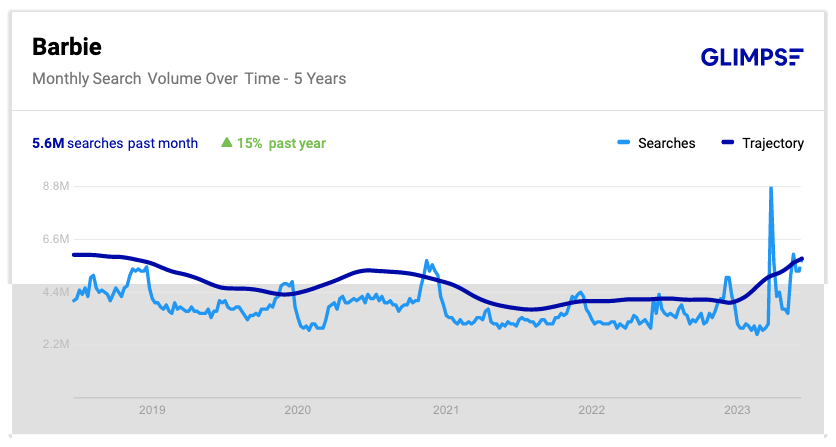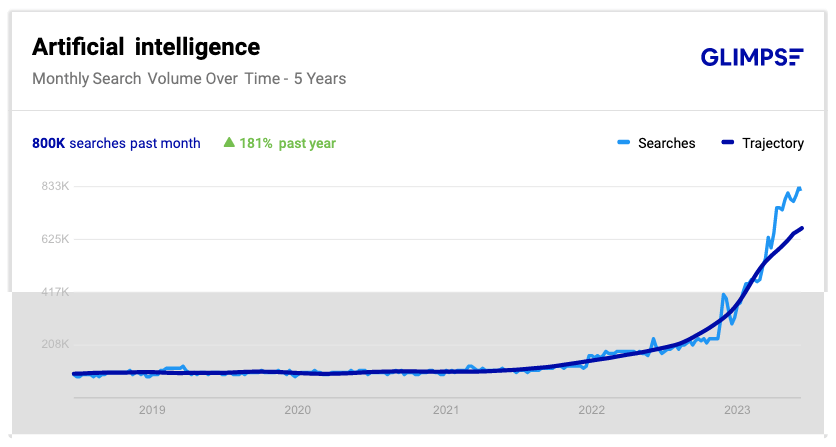Key Points
- Through reception marketing, brands can tap into consumer insights using Google Trends.
- Brands can utilize Google Trends to understand what audiences care about in real time, then build content that satisfies their interests.
- Brands that understand their audiences can create engaging and relevant strategies to connect on a deeper level.
Today’s consumers behave differently than they did five to ten years ago. They have more information at their fingertips than ever before, and as a result, are more empowered than ever before.
This poses a challenge for brands to find unique ways to not just get in front of consumers — but to authentically connect with them.
To establish strong relationships, brands need to show target audiences that they understand them and their interests. This approach fosters empathy and relatability, and increases the likelihood of conversion.
Companies can embrace consumer empowerment by adopting strategies built on consumer behavior data. In this post, we’ll discuss how brands can utilize tools like Google Trends to identify consumer interests and create memorable (and maybe even viral) content experiences.
How to uncover audience interests
By identifying what captivates and intrigues target consumers, brands can tailor offerings, messaging, and overall brand experience to their preferences. But how can brands determine what their audiences care about?
The best way is for brands to listen to what their customers are discussing, reading, and searching for online through social listening and Google search data. Brands can tap into this data through tools like Google Trends and Semrush, to get a better understanding of what people care about in real time.
Organic search data allows brands to get an unfiltered view of their audience’s curiosities, interests, and problems. It provides real-time information about what consumers are actively searching for at any given moment. It captures the latest trends, emerging topics, and shifting preferences.
By monitoring and analyzing organic search data, brands can stay ahead of the curve and align strategies with the evolving interests and needs of their target audience.
What is Google Trends?
Google Trends is a powerful (and free) tool that provides long- and short-term insight into the most popular search terms. It measures search term popularity on a 0 to 100 scale, popularity in relation to other terms, geographical data, and more.
What individuals search for opens a window into what people are thinking about — their needs, motivations, and problems. The tool can be harnessed to show trends across individual searches, revealing common threads and interests across large groups. That’s why it’s a perfect fit for the reception marketing approach.
Why it works
By incorporating popular search terms, whether they are related to media trends, pop culture, or current events, you create a seamless connection between your brand and the zeitgeist — further strengthening the bond with your audience.
Brands that are attuned to audience interests and preferences can go beyond simply selling products or services. Instead, they create brand experiences that genuinely connect with your target market, making them feel understood, valued, and inspired to engage on a deeper level.
This connection paves the way for successful conversions, as customers are more likely to trust and invest in a brand that aligns with their interests and offers tailored solutions to their needs.
Brands can utilize this insight to create owned, managed, and leveraged assets with multiple touchpoints across channels. Relevant content assets that run parallel to your brand are primed for earned media opportunities, email newsletters, social posts, and optimized blog posts that maximize impact and reach.
An example: executing a Google Trends strategy
To illustrate just how powerful a strategy built on Google Trends data can be, Terakeet created a series of content assets based on two recent trending topics: Barbie and Artificial Intelligence (AI).
In recent months, these terms showed an uptick in search popularity, which we detected using Google Trends.
From these insights, our team got to work creating engaging assets that would captivate the attention of consumers interested in one, or both, topics. These assets could then be leveraged on owned or third-party channels to generate connection and brand awareness.
The result was a set of realistic, AI-generated images of Barbie’s Dreamhouse as if it existed today.
Let’s break down how we did it.
Identifying the Barbie & AI trends
In early 2023, the Terakeet team recognized growing curiosity and interest around the Barbie brand and upcoming film, thanks to Google Trends data.
As time went on, growth continued and Barbie as a search topic peaked the week of April 2, 2023. Digging deeper, we uncovered 1.9 million searches occurring that week.
Prior to that, Barbie’s peak search interest was the week of December 23, 2018, with 1,958,579 searches. Notable moments during that period included the announcement of the same-*** couple Barbie and a video of Jason Mamoa reading “Barbie ****” lyrics during the Aquaman press tour.
Due to hype around the release of the Barbie film in July 2023, the attention and conversation were only expected to grow. Terakeet identified the topic as an opportunity to capitalize on the hype and connect with new audiences.

Through early and mid-2023, the topic continued to pick up steam and interest peaked at 5.4 million Barbie-related Google searches from March 25 to April 21. The peak happened the week of April 4, when the Barbie movie trailer dropped, resulting in 460K searches that week alone.
In addition to heightened interest in Barbie, the team also identified rising trends around AI topics. To broaden the audience and maximize the campaign’s impact, we brainstormed ways to merge these two topics.

Recognizing the immense popularity of both subjects — we also tapped into the current curiosity and fascination surrounding AI technology.
The campaign sought to engage audiences with AI-generated images that breathed new life into the iconic Barbie brand. The result? Visually stunning and diverse representations of Barbie’s Dreamhouse.



This combination is designed not only to garner attention but also to resonate deeply with the audience, as it addresses both two culturally-significant topics at the exact moment in time they rose in popularity.
Leveraging the content assets
After the creation of the Barbie content assets comes the strategy to deploy them to connect with consumers in relevant moments. Brands have a tremendous opportunity to maximize the reach and impact of their content by strategically leveraging content assets across their network and channels.
Although this is only an example, brands could then deploy the images across their owned, managed, and leveraged assets. For example:
Owned — Create blog posts, website content, and internal communications.
Managed — Share on social media accounts, emails, newsletters, advertisements, bylines, etc.
Leveraged — Pitch to influencers, third-party publishers, inspiration for user-generated content, etc.
Learn more about your network of assets and the hierarchy that connects them through the MACH-6.
Using the Barbie-AI images, brands can create a variety of content types, such as:
- Articles
- Videos
- Infographics
- White papers
- Presentations

As a result, brands have a repository of high-quality material that can be shared and repurposed across various platforms.
The impact
Connection is often more important in the long term than immediate and direct conversions. The strategy outlined here is about connecting with consumers through exceptional content that they actually care about.
People will remember how your content makes them feel and start to build trust with your brand before they’re even in your buyer’s journey. This pre-journey work gives people something to connect with, get excited about, and influence a purchase down the line.
This example campaign stands as a testament to the power of leveraging trending topics and embracing emerging technologies to create assets that capture the hearts and minds of consumers.
By generating interesting and relevant content that resonates, marketers hold the keys to building trust and establishing a lasting connection with their target audience. Trust is that long-term goal, a delayed gratification that reaps bigger rewards than a few conversions today.
This approach enables brands to make a positive impression and build loyalty long before individuals are ready to purchase — setting the stage for fruitful relationships and increased conversions in the future.
Final thoughts
Google Trends is full of valuable data that can fuel out-of-the-box strategies. And the best way to learn more about your consumers through organic search data is to experiment.
Test different keywords, topics, and comparisons. Use different timelines, categories, and geographic settings. Keep an eye on trending searches. Get curious.
The more you explore, the more you’ll unearth important insights about your target audience. Leverage that information to ensure your consumers meet your brand when they’re exploring interests and trying to solve problems. Be ready with unique content experiences to truly connect with them.
Your audience cares about more than what your products can do and the narrative you want to share. If your brand can become part of their daily lives and offer them engaging content that appeals to their interests, they’ll already trust you when it comes time to purchase.
